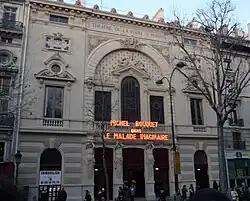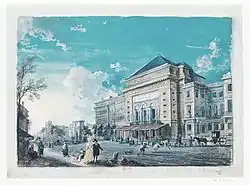Théâtre de la Porte Saint-Martin
The Théâtre de la Porte Saint-Martin is a venerable theatre and opera house at 18, Boulevard Saint-Martin in the 10th arrondissement of Paris.
 The Théâtre de la Porte Saint-Martin in 2009 | |
| Address | 18 Boulevard Saint-Martin |
|---|---|
| Location | Paris, France |
| Coordinates | 48°52′8.5″N 2°21′24″E |
| Type | Theatre |
| Construction | |
| Opened | 1781 |
| Renovated | 1873 |
| Architect | Oscar de la Chardonnière |
| Website | |
| www | |
History

It was first built very rapidly in 1781 under the direction of Nicolas Lenoir (1726–1810) to house the Paris Opéra, whose previous home, the second Salle du Palais-Royal, had burned down on 8 June 1781. The new theatre had a capacity of about 2,000 spectators and included a parterre with the lowest-priced tickets sold only to males who stood throughout the performances, an amphitheatre, and four rows of boxes. The Opéra used the theatre from 27 October 1781 until August 1794.[1][2]
The theatre was destroyed by fire during the Paris Commune of 1871 and replaced in 1873 with a building designed by the architect Oscar de la Chardonnière (d. 1881), who enlisted the aid of the sculptor Jacques-Hyacinthe Chevalier (1825–1895) in the design of the new facade. The new interior was designed by H. Chevalier.[2] With relatively brief interruptions, the theatre has been in continuous operation since.
Premieres
- 1783: La caravane du Caire, opéra-ballet in three acts by André Grétry
- 1787: Tarare, opéra (tragédie lyrique) by Antonio Salieri
- 1806: Ramire, ou le fils naturel, melodrama in 3 acts by Philippe Jacques de La Roche, music by Francesco Bianchi.
- 1818: Les Deux Colons, a one-act play interspersed with verses by Joseph Aude and James Harvey D'Egville
- 1841: Les Farfadets, a "ballet-féerie" by Auguste Pilati
- 1849: Le Postillon de Saint-Valéry, opéra-comique by Auguste Pilati
- 1849: Le pasteur, ou l’evangile et le foyer, a play by Émile Souvestre and Eugène Bourgeois
- 1874: a stage version of Jules Verne's Around the World in Eighty Days, adapted by Verne and Adolphe d'Ennery, which ran 415 performances[3] (before its subsequent very long run at the Théâtre du Châtelet)
- 1880: L'Arbre de Noël, operetta by Alexandre Charles Lecocq and Georges Jacobi
- 1887: La Tosca, written by Victorien Sardou for Sarah Bernhardt, with a hugely successful first run of 200 performances
- 1897: the original Cyrano de Bergerac, the best-known work of Edmond Rostand, with Benoît-Constant Coquelin in the title role
- 1907: The Affair of the Poisons, final play by Victorien Sardou
- 1914: Monsieur Brotonneau, play by Gaston Arman de Caillavet and Robert de Flers
Three of the above were the basis of opera libretti:
- Verdi's Stiffelio was based on Le pasteur, ou l’evangile et le foyer
- Puccini's Tosca was based on La Tosca
- Alfano's Cyrano de Bergerac was based on Cyrano de Bergerac
The theatre's other productions have included the ballet Leda, the Swiss Milkmaid (1823) and works by Dany Boon, Charles-Gaspard Delestre-Poirson and Gaston Arman de Caillavet.
See also
References
- "Paris" 3: 862, 867. Sadie, Stanley, ed. (1992). The new Grove dictionary of opera (4 volumes). London: Macmillan. ISBN 978-1-56159-228-9.
- "Atlantes et cariatides des grands boulevards - Paris.fr" (in French).
- "Orange". Retrieved 1 September 2016.
External links
- Official web site.
- Facade of the current theatre. Google Maps street view at 18, boulevard Saint-Martin.